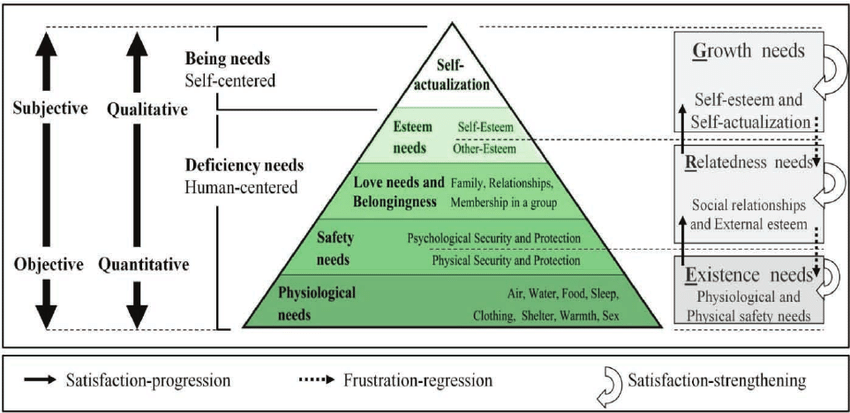
•As a refinement of Maslow’s theory Clayton Alderfer proposed a hierarchy of three core needs.
- Existence needs (E) -physical well being ; physiological needs ( food, water, air,and shelter) and safety-related needs (health, secure employment, and property).
- Relatedness needs (R)- satisfactory relations with others; love/belonging-related needs ( friendship, family, and sexual intimacy) and esteem-related needs (respect).
- Growth needs (G) – development of competence and realization of potential ; esteem-related needs (self-confidence, self-esteem, and achievement) and self-actualization needs (creativity, morality, problem-solving, and discovery)
•This is very similar to Maslows, but into three tiers. •But may be a bit more rational.
•For illustration, sex does not appear in the bottom category as it is in Maslow’s model, since it is not crucial to (the individual’s) existence.
•Alderfer believed that as you start satisfying higher needs, they become more intense. It is like an addiction.
•For instance -the more power you get the more you want power.
2 Equation in Adlerfer’s ERG Motivation Theory-
- Satisfaction-progression
- Individuals move up the need hierarchy as a result of satisfying lower order needs. In Alderfer’s ERG theory, this isn’t necessarily so. The progression upward from relatedness satisfaction to growth desires does not presume the satisfaction of a person’s existence needs.
- Frustration-regression
- Frustration-regression suggests that an already satisfied need can become active when a higher need cannot be satisfied. Thus, if a person is continually frustrated in his/her attempts to satisfy growth, relatedness needs can resurface as key motivators.
•Reference for Alderfer’s ERG Motivation Theory–
Alderfer, C. P., Existence, Relatedness, and Growth; Human Needs in Organizational Settings, New York: Free Press, 1972
Alderfer, C.P. (2005). The Five Laws of Group and Intergroup Dynamics.
Subscribe to Careershodh
Get the latest updates and insights.
Join 16,422 other subscribers!
Niwlikar, B. A. (2020, December 8). What is Alderfer’s ERG Motivation Theory?. Careershodh. https://www.careershodh.com/what-is-alderfers-erg-motivation-theory/
